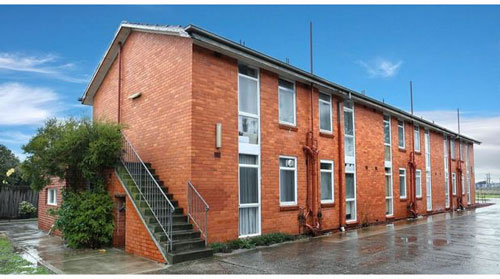Melbourne unit owners could be forced to sell their homes to developers
The Age
Aisha Dow
11 June 2017
"Decaying" old apartment buildings around Melbourne could be demolished
and sold to developers under proposed reforms that could see people's
homes forcibly acquired.
As it stands, any plan to sell a building must be approved by 100 per
cent of owners, making sales of ageing apartment complexes near
impossible.
The Andrews government is considering reforms that could result in the
voting requirement for sales and redevelopments reduced to as little as
75 per cent.
While these laws would likely see the replacement of many old
"six-pack" blocks built in the 1950s to 1970s in desirable suburbs such
as Toorak and South Yarra, there is also concern it would force people
to relinquish their perfectly liveable homes at the bidding of their
neighbours.

Ageing six-pack flats like this could become the new target of developers.
Photo: Domain
Similar laws have already been introduced in New South Wales, but not
without controversy, due to fears it could drive vulnerable
owner-occupiers, including the elderly, out of their homes.
University of New South Wales strata law expert, Associate Professor
Cathy Sherry, said people seemed to have been convinced that they had
"some sort of democratic right to their neighbour's property" – but
they don't.
"In a liberal democracy I don't think there is any justification for
someone to lose their home just because their neighbours will make a
lot of money," she said.
Associate Professor Sherry said such laws should only be welcomed when
a building was facing major repairs and further maintenance was
pointless.
But plenty of Victorians argue that it is unfair that a single
homeowner is able to stymie the wishes of dozens, even hundreds, of
other owners. A number of people have made submissions on the planned
reforms to the Owners Corporation Act, supporting an 80 per cent vote
threshold for a sale of buildings more than 30 years old.
Mortgage broker Clint Bravo has been working with his neighbours
attempting to sell a 60-year-old apartment building on St Kilda Road.
He says just one of the 29 lot owners is refusing to sell, denying the
rest the healthy profits likely to be gained from selling off a block
in one of Melbourne's most desirable apartment tower precincts.
Mr Bravo said the building was also riddled with defects, including concrete cancer and significant water leaks.
"The owners can't afford to put the money in. Not everyone is wealthy,"
he said. "Everyone wins [from the sale]. If you have one or two people
that are being greedy or doing it for their own purposes and holding
back development, there is a problem."
Many body corporate managers also believe it should be easier to
redevelop decaying buildings, or older units occupying prime
development sites.
"Just as owners in a freestanding house can make a decision to
renovate, or to completely rebuild, that's all we are really asking for
– that people be given the choice to do what they want to do with the
building," Strata Community Australia Victorian general manager Rob
Beck said.
The government's ongoing review of the Owners Corporation Act is
exploring a range of different models for easier sale of strata blocks.
One of the models would keep the 100 per cent vote requirement for
buildings younger than 15 years, 95 per cent for buildings 15 to 20
years old and 80 per cent for buildings older than 30 years. Another
would require the approval of any sale by the Victorian Civil and
Administrative Tribunal (VCAT).
A 75 per cent threshold and model similar to that in NSW has the
support of the Law Institute of Victoria, as long as VCAT considers the
issues raised by minority lot owners before approving a plan.
The Andrews government says it is yet to form a view as its review into Victoria's property laws is ongoing.
Properties likely to be first targeted in any future apartment block
sales include walk-up buildings constructed more than 35 years ago in
inner South East suburbs including Hawthorn, Richmond, South Yarra and
Toorak.
top contents
chapter previous next
